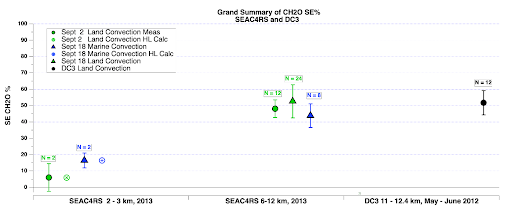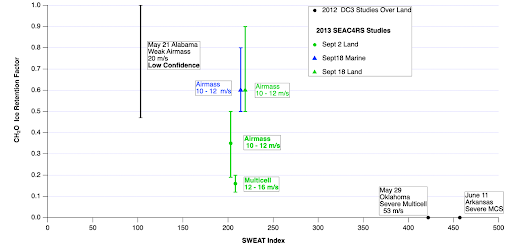Wet scavenging of trace gases in convection over land versus water
Transport via convective clouds is a major pathway for rapidly moving trace gases, aerosols, and water from the boundary layer to the upper troposphere. Many trace gases that have chemical lifetimes greater than a few hours and are not soluble, like carbon monoxide, alkanes, and alkenes, are subject to this transport. In contrast, trace gases that are soluble, like nitric acid, hydrogen peroxide (H2O2), formaldehyde (CH2O), and methyl hydrogen peroxide (CH3OOH), can be removed from the atmosphere via wet scavenging by cloud hydrometeors, such as cloud drops, rain, snow, and graupel. Gustavo Cuchiara (now at CIRA, Ft. Collins, Colorado) and Alan Fried (U. Colorado) in collaboration with ACOM scientists have investigated the scavenging efficiency of H2O2, CH2O, and CH3OOH, trace gases that are important precursors to ozone formation in the upper troposphere. Recent work has contrasted the scavenging efficiency of these trace gases in convection occurring over land versus convection occurring over the Gulf of Mexico sampled during the NASA SEAC4RS field campaign. In comparison to land convection, marine convection tends to have lower cloud condensation nuclei (CCN) number concentrations, lower updraft velocities, and lower cloud bases giving more precipitation formation via cloud drop coalescence. Thus, the cloud dynamics and physics can potentially affect the amount of removal of soluble trace gases.
On September 18, 2013, the NASA DC8 aircraft sampled convective clouds over the Gulf of Mexico and over land near San Antonio, Texas that were in the same general southeasterly low-level flow with moderate instability and convective available potential energy. The marine convection did indeed have lower CCN concentrations, updraft velocities, and cloud base height. However, the analysis of H2O2, CH2O, and CH3OOH mixing ratios in the inflow and outflow regions of the two storms revealed that the scavenging efficiencies (percent of the trace gas removed by precipitation) of these trace gases were not significantly different between the land and marine convection. As an example, Figure 1 shows the scavenging efficiency (SE) for CH2O for land convection (green markers) and marine convection (blue markers) at two different altitudes and are compared to the high-altitude SE results from the DC3 campaign. For all cases at altitudes above 6 km, CH2O SE is 40-50% on average.

At higher altitudes (above 4 km), the ice, snow, and graupel in the storm play an active role in scavenging soluble trace gases. A key process for the scavenging in the region where cloud drops and ice co-exist is the fraction of soluble trace gases that are retained in the frozen cloud particles when cloud drop freezing occurs. Simulations with the WRF-Chem model allow us to investigate what the retention fraction is for soluble trace gases. Curiously, the retention factor for CH2O varies substantially among case studies (Figure 2) and in comparison to wind tunnel experimental data. Figure 2 shows that there appears to be a correlation between the severity of the storm as measured by the Severe Weather Threat Index (SWEAT) and the CH2O retention factor, where more severe storms have a lower retention factor than weaker storms. We hypothesize that the cause of this correlation is the stronger turbulence in severe storms causing ice shattering and water shedding which allows dissolved CH2O to be released back to the gas phase.
